
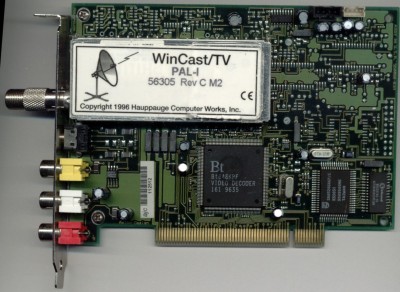 |
Hauppuage WinCast/TV - 1996 Another reference design, this one being the BT848 from 1996. The AVerMedia card looks a lot better than this one with its image quality (and aspect ratio support), but both suffer from the RFI generated within today's computers. The Hauppauge especially takes a lot of sound degradation. When this thing was new, the top level PC was around a Pentium133, nowhere near the level required to deinterlace and process real time full resolution video. As a result, the software halved the horizontal resolution and didn't bother deinterlacing at all, just showing one field after the other in a hardware overlay. The BT848 chip was the predecessor of the BT878, and lacks audio suppport completely. Typically, cards would just handle audio themselves using extra components out of the tuner. |
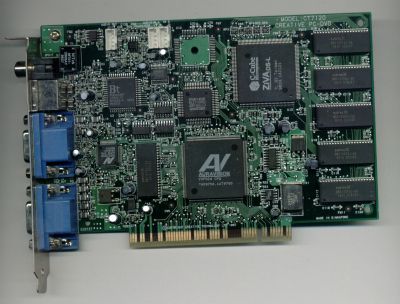 |
Creative DXR2 - 1997 Marketed as "PC-DVD Encore" and with a 2x DVD-ROM drive included, the hardware DVD decoder filled the gap before CPUs were really powerful enough to handle DVD decoding unassisted, wich was all of roughly six months. An unassisted AMD K6-350 could just about handle a DVD, as could a Pentium-II 300. The MPEG-2 decoder is the ZiVA-DS chip, the VXP524 is a PCI video processor, the CT7115 a simple audio DAC and the BT865 is a video encoder. In this case, the BT865 outputs NTSC or PAL S-video. The NPN chips are Nanya 256kx16 EDO DRAM chips of 512kB capacity. With six of them, the DXR2 has 3MB of onboard memory, just enough for a PAL framebuffer with a bit of space for scratch and workspace. What's going on with the connectors at the back? Two blue VGAs?! You'd connect your video card to the DXR2, then the DXR2 to the monitor. Compatible players, Creative's own, would then take over the video output, resulting in full screen DVD playback. A DXR2 could not decode DVDs in a window. |
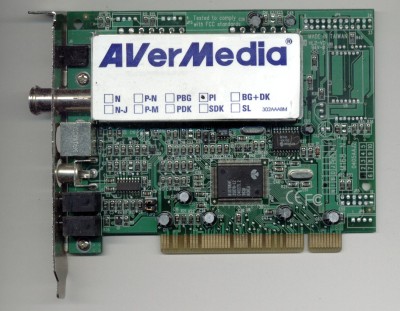
|
AVerMedia TV Capture 98 - 1998 This model is a fairly standard BT878 implementation, it implements an IR remote control. The FM radio tuner of the BT878 is not implemented in AVerMedia's software, although it can be used with freely available software. The tuner is a Philips PAL-I and this card is fully supported by DScaler. Unfortunately, the card has inadequate grounding and suffers the "eight vertical noise bars of death", a condition caused by the ground planes of the card being at different potentials. To eradicate it, scrape off a little of the PCB green coating from each ground plane and solder a wire between them, finally connecting it to the metal of the back plate. With this device, I hooked up a PlayStation2 to my PC, handled audio by fibre optic TOS-Link (and a Hercules Fortissimo II card to receive it), and could play PS2 games in a window on my PC. Or full screen, with correct aspect ratio, if I so chose. The BT878 (and earlier BT848) is one of the unsung greats of the PC world. With a piece of software called DScaler4, your PC was not just a dodgy TV-in-a-window thing, but a fully fledged TV viewer with full scaling, deinterlacing, colour controls and everything you'd expect from a TV which wasn't to actually exist for another five years or so. Deinterlacing was bob, weave, even or odd fields, right until someone took motion compensation algorithms, CPUs fast enough to run them, and did them in realtime in DScaler. "TomsMoComp" was far and away superior to any other deinterlacer. No "TV on PC" system has ever got it quite as right as DScaler on a BT878 did, in 2001. Windows Vista's "Media Center" (which Microsoft was actually phasing out) was one of its unsung successes and got there, where DScaler had been, five years before. |
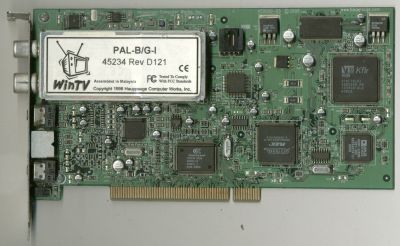
|
Hauppuage WinTV PVR PCI - 1998 A rarity among this collection, the PVR PCI variant of their WinTV (formerly the WinCastTV, see above) put Hauppuage on the map. It featured expensive, specialised hardware for MPEG2 encoding on the fly and so was immune to the PCI bus bandwidth problems of other cards, but it did need a meaty CPU. The video digitiser is Brooktree (Bought by Rockwell, now Conexant, in 1996) BT878A, very common on these cards. Right of the BT878A is an Altera FLEX programmable logic array which appears to handle bootstrapping. The MPEG2 encoder begins with an Analog Devices ADSP-2185M digital signal processor and microcontroller (which was amazingly still in production as of 2014 and still being used in new devices, such as Skype phones and other stream processing devices). The VisionTech Kfir is a hardware MPEG2 encoder, the chip just above it is an SDRAM. The Kfir was commonly seen in hardware MPEG2 encoders (DVD recorders and PCI cards) and a multitude of other devices expected to encode MPEG2 streams. As a PCI card, the WinTV PVR PCI stood pretty much unmatched. Its high quality construction (part of being four times more expensive than the contemporary AVerMedia TVCapture98 on this page) rendered it immune to noise bars but it was still a niche product and didn't sell too well. This card will work in WindowsXP, but a convoluted four stage driver and software installation is needed. |
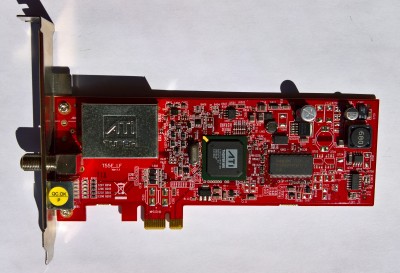
|
ATI Theatre 550 - 2005 Bryan McIntosh is back digging into his seemingly endless pile of old hardware, with a ATI Theatre 550: I bought this when I moved into my first apartment and wanted to have a DVR and a way to watch a different TV show on our analog cable service than my roommate was watching, and this card fit the bill since it worked well with Windows Media Centre under Windows Vista. I used it until 2012, when I upgraded to Windows 8.1 and analog cable went the way of the dinosaur. This card was affordable, fit in a PCI-E slot, and had reasonable driver support. There's a connector on the back that looks like a variant of a S-Video connector, but it's likely meant for some type of A/V breakout box that I've never taken the time to track down. It's currently sitting around waiting for me to find some other use for it; since it only has coaxial input, it's not terribly useful for getting good quality captures of old analog video or retro gaming.Windows Media Centre (WMC) was one of Vista's unsung heroes. I had a small USB DVB-T tuner and WMC turned my PC into a full on personal video recorder (PVR) with a well designed, readable, interface. The programme guide was excellent and the remote control bundled with the cheap USB tuner just worked out of the box. It was stunningly slick in a world where cheap Chinese hardware had unusable interfaces. Anyway, you're here for the ATI Theatre 550! ATI's cable tuners were woefully undersold, as the concept of watching TV on a PC didn't really catch on. The Theatre 550 was one of the only cards on the market with both a PCI Express interface and the capacity to handle analogue cable signals. The world would go digital at about the same time as the PCI/PCIe transition. Bryan thinks the non-cable (cable is the threaded connector, usually labelled CATV) connector is for a breakout box. He's quite right, it's for a breakout which handles S-video, composite and RCA stereo audio. The ATI Theatre 550 Pro chip (this was used on the Theatre 550 and Theatre 550 Pro models) was an MPEG-2 encoder, it was paired with the ATI T-1 TV and FM radio tuner and demodulator. All Threatre 550 products offered 12 bit video digitisation, five line comb filtering (useful for RF and composite sources) and a 3D comb filter to reduce colour aliasing ("colour bleed"). In a first for ATI, the Theatre 550 could also handle the audio itself. Earlier ATI Theatre and All-In-Wonder products offered an audio output to be linked to the AUX or TV of a sound card and were purely video processors. Like the Hauppuage WinTV PVR-PCI, also on this page, it did MPEG-2 in hardware so would never drop a frame. ATI bundled Cyberlink software and IR remote with this product, which were perhaps not the greatest UIs ever made. Presumably Bryan was as pleasantly surprised as I was when Vista's MCE just did it all itself. |
 Hattix hardware images are licensed under a Creative Commons Attribution 2.0 UK: England & Wales License except where otherwise stated.
Hattix hardware images are licensed under a Creative Commons Attribution 2.0 UK: England & Wales License except where otherwise stated.